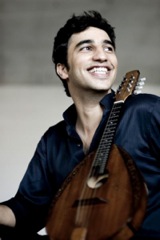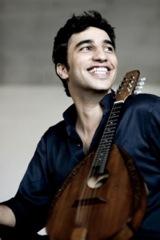But the adventuresome San Francisco Chamber Orchestra will present Israeli mandolin virtuoso Avi Avital as guest soloist for “Mandolin Magic,” its next home concert, with free shows around the Bay Area March 18-22, essaying both the famous Bach Violin Concerto in A Minor and Beethoven’s lesser-known Andante con Variazioni, as arranged by SFCO composer in residence Gabriela Lena Frank.

This mandolin double feature will be sandwiched between Arcangelo Corelli’s Concerto Grosso, Op. 6, No. 8, and Argentine composer Osvaldo Golijov’s Last Round for Strings, an elegy for nuevo tango maestro Astor Piazzolla that treats the orchestra itself as a bandoneon, Piazzolla’s — and tango’s — lead instrument.
SFCO Music Director Ben Simon promises Piazzolla music for encores, including the piece on which Golijov based the second part of Last Round, called The Death of Angels.
Simon speaks of mandolinist Avital as “a wonderful virtuoso on an instrument you never see in front of an orchestra. It’s not that well-known a classical instrument. But it has the same four strings, and is tuned the same way as a violin. It was a very popular 19th-century salon instrument, like the guitar and piano. I don’t know if many people think of the mandolin as a serious instrument. I’m a violist myself; I understand neglected instruments. Nobody writes for viola! So I’m sympathetic to instruments that deserve their time in the sun. And I’m a big bluegrass fan; I listen to David Grisman.”
Simon tells of how he developed the program with Avital. “It was his idea to do the Bach, which he’s played with other orchestras. What else could be done with mandolin and strings? He told us Beethoven composed a piece in his 20s, for mandolin and harpsichord. He was stretching his wings a little bit. So we had Gabi Frank, who’s our first composer-in-residence, orchestrate it.
“It’s really for mandolin, but not for orchestra; the Bach’s really for orchestra, not the mandolin. We’re playing fast and loose! But Bach wouldn’t mind; he transcribed things all the time for different instruments.”
Watch Avi Avital
Last Round features a double string quartet, “with instructions from the composer that the quartets face each other, playing off each other, syncopating, with a double bass in the middle, between them. Golijov wrote that, with the bows flashing, the orchestra should be like tango dancers with criss-crossed legs. The whole orchestra is like an idealized bandoneon; the first, faster part like the compression [of the instrument’s bellows], the second — and slower — part like the expansion of the instrument, slowly sucking in air.”
Golijov, who has credited Piazzolla as his inspiration to become a composer, has said, “He was not afraid to be both high and low, popular and classical ... He wasn’t simply using notes, he was distilling all of the life in Buenos Aires: the way people talked, walked, flirted, fought. He skirted all of the big European existential questions. But we didn’t have to ask ourselves those same questions. We did not attempt to destroy the world.”

